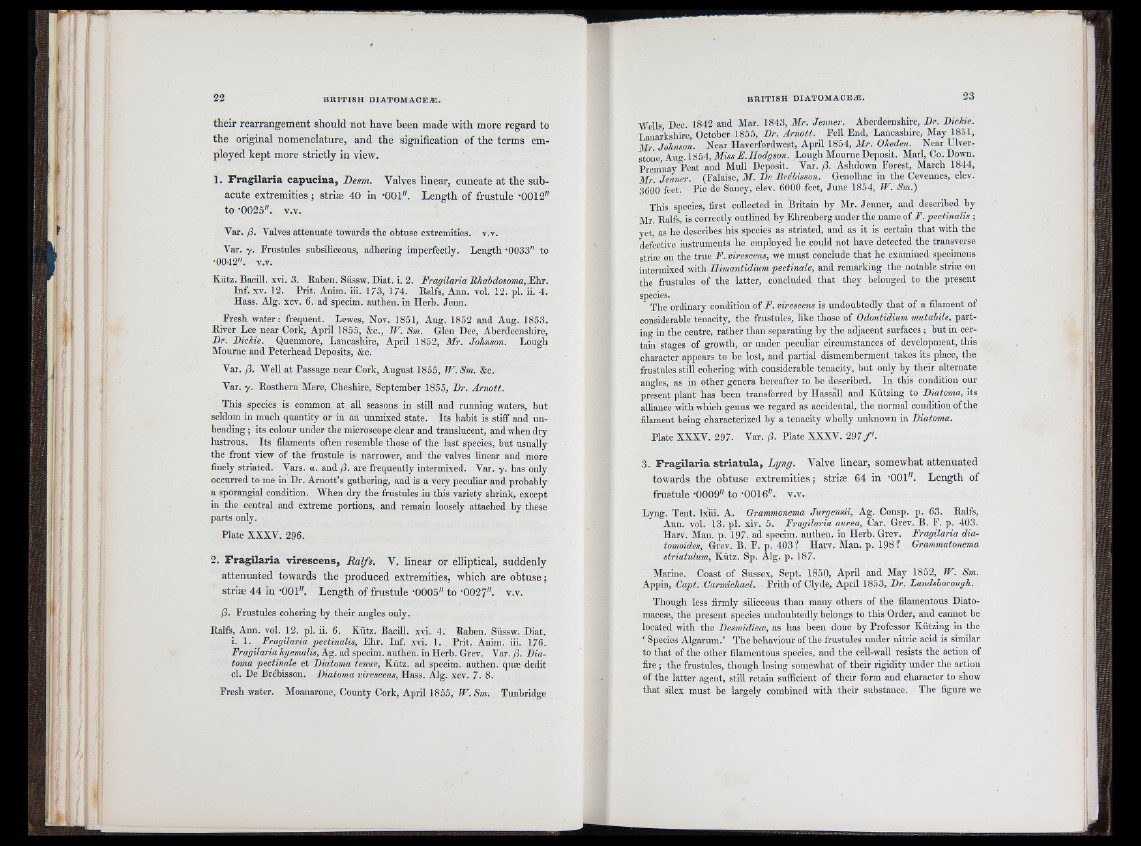
their rearrangement should not have been made with more regard to
the original nomenclature, and the signification of the terms employed
kept more strictly in view.
1. Fragilaria capucina, Desm. Valves linear, cuneate at the subacute
extremities ; striæ 40 in -OOl". Length of frustule -0012"
to -0025". v.v.
Var. /3. Valves attenuate towards the obtuse extremities, v.v.
Var. y. Frustules subsiliceous, adhering imperfectly. Length ’0033" to
•0042". v.v.
Kiitz. Bacill. xvi. 3. Raben. Siissw. Diat. i. 2. Fragilaria Rhabdosoma, Ehr.
Inf. XV. 12. Prit. Anim. iii. 173, 174. Ralfs, Ann. v o l. 12. p i . ii. 4.
Hass. Alg. xcv. 6. ad specim. authen. in Herb. Jenn.
Fresh water: frequent. Lewes, Nov, 1851, Aug. 1852 and Aug. 1853.
River Lee near Cork, April 1855, &c., W. Sm. Glen Dee, Aberdeenshire,
Dr. Dickie. Quenmore, Lancashire, April 1852, Mr. Johnson. Lough
Mourne and Peterhead Deposits, &c.
Var. /3. Well at Passage near Cork, August 1855, TF. Sm. &c.
Var. y. Eosthern Mere, Cheshire, September 1855, Dr. Arnott.
This species is common at all seasons in still and running waters, but
seldom in much quantity or in an nnmixed state. Its habit is stiff and unbending;
its colour under the microscope clear and translucent, and when dry
lustrous. Its filaments often resemble those of the last species, but usually
the front view of the frustule is narrower, and the valves linear and more
finely striated. Vars. a. and ji. are frequently intermixed. Var. y. has only
occurred to me in Dr. Amott’s gathering, and is a very peculiar and probably
a sporangial condition. When dry the frustules in this variety shrink, except
in the central and extreme portions, and remain loosely attached by these
parts only.
Plate XXXV. 296.
2. Fragilaria virescens, Ralfs. V. linear or elliptical, suddenly
attenuated towards the produced extremities, which are obtuse;
striæ 44 in -OOl". Length of frustule -0005" to -0027". v.v.
/3. Frustules cohering by their angles only.
Ralfs, Ann. vol. 12. pi. ii. 6. Kiitz. Bacill. xvi. 4. Raben. Siissw. Diat.
i. 1. Fragilaria pectinalis, Ehr. Inf. xvi. 1. Prit. Anim. iii. 176.
Fragilaria hyemalis, Ag. ad specim. authen. in Herb. Grev. Var. /3. Diatoma
pectinale et Diatoma tenue, Kütz. ad specim. authen. quæ dedit
cl. De Bre'bisson. Diatoma virescens, Hass. Alg. xcv. 7. 8.
Fresh water. Moanarone, County Cork, April 1855, TV. Sm. Tunbridge
Wells Dec. 1842 and Mar. 1843, Mr. Jenner. Aberdeenshire, Dr. Die/cie.
Lanaikshire, October 1855, Dr. Arnott. Fell End, Lancashire, May 1851,
3Ir Johnson. Near Haverfordwest, April 1854, Mr. Okeden. Near Ulverstone,
An»-. 1854, Miss E.Hodgson. Lougli Mourne Deposit. Marl, Co. Down.
PreinnayYeat and Mull Deposit. Var. ¡3. Ashdown^ Forest, March 1844,
Mr Jenner. (Falaise, M. De Brébisson. Genolhac in the Cevennes, elev.
3600 feet. Pic de Sancy, elev. 6000 feet, June 1854, lU. Sm.)
This species, first collected in Britain by Mr. Jenner, and described by
Mr. Ralfs, is correctly outlined by Ehrenberg under the name of F. pectinalis ;
yet, as he describes his species as striated, and as it is certain that with the
defective instruments he employed he could not have detected the transverse
striæ on the true F. virescens, we must conclude that he examined specimens
intermixed with Himantidium pectinale, and remarking the notable striæ on
the frustules of the latter, concluded that they belonged to the present
species.
The ordinary condition of F. virescens is undoubtedly that of a filament of
considerable tenacity, the frustules, like those of Odontidium mutabile, parting
in the centre, rather than separating by the adjacent surfaces ; but in certain
stages of growth, or under peculiar circumstances of development, this
character appears to be lost, and partial dismemberment takes its place, the
frustules still cohering with considerable tenacity, but only by their alternate
angles, as in other genera hereafter to be described. In this condition our
present plant has been transferred by Hassall and Kützing to Diatoma, its
alliance with which genus we regard as accidental, the normal condition of the
filament being characterized by a tenacity wholly unknown in Diatoma.
Plate XXXV. 297. Var. ¡3. Plate XXXV. 2 9 7 /'.
3 . Fragilaria striatula, Lyng. Valve linear, somewhat attenuated
towards the obtuse extremities ; striæ 64 in •OOl". Length of
frustule -0009" to -0016". v.v.
Lyng. Tent, ixiii. A. Grammonema Jurgensii, Ag. Consp. p. 63. Ralfs,
Ann. vol. 13. pi. xiv. 5. Fragilaria aurea. Car. Grev. B. F. p. 403.
Harv. Man. p. 197. ad specim. authen. in Herb. Grev. Fragilaria dia-
tomoides, Grev. B. P. p. 403? Harv. Man. p. 198? Grammatonema
striatulum, Kütz. Sp. Alg. p. 187.
Marine. Coast of Sussex, Sept. 1850, April and May 1852, TF. Sm.
Appin, Capt. Carmichael. Frith of Clyde, April 1853, Dr. Landsborough.
Though less firmly siliceous than many others of the filamentous Diatomaceæ,
the present species undoubtedly belongs to this Order, and cannot be
located with the Desmidieæ, as has been done by Professor Kützing in the
‘ Species Algarum.’ The behaviour of the frustules under nitric acid is similar
to that of the other filamentous species, and the cell-wall resists the action of
fire ; the frustules, though losing somewhat of their rigidity under the action
of the latter agent, still retain sufficient of their form and character to show
that silex must be largely combined with their substance. The figure we